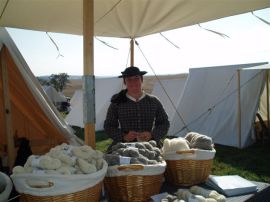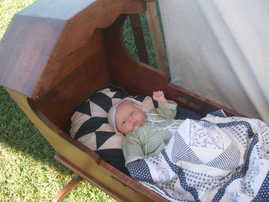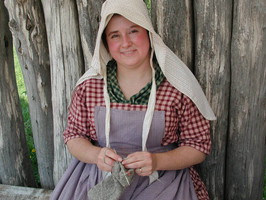
Suzy's Biography
It seems like I’d always been interested in history, although I’d have to say the first real start was with the wonderful songs and stories of my 7th grade social studies teacher, Mrs.
Maude.
In college I majored in history while working during the school year at the campus museum, and at the same time I started Civil War reenacting.
After college, with my history degree in hand and big dreams in my heart, I started working -- drum roll, please -- as a secretary! So much for the value of a history degree! But I continued with my Civil War reenacting in the summer, and in the winter months I volunteered as a costumed interrupter at Kline Creek Farm, an 1890s living history museum. At "The Farm" I worked in the house, spending each morning cooking the noon meal on a wood burning stove and using 1890s kitchen utensils. Afternoons were spent cleaning and sewing. As I worked I explained my activities to visitors, inviting them to ask questions and even "help," and each hour, on the hour, I gave an extended tour of the home.
I had started out as a farb (don’t we all?), but as I learned more I strove to make both my 1860s and my 1890s impressions more authentic. I started with my clothes and appearance, and then
branched out to what activities a Victorian woman would be doing to occupy her time. That’s when I discovered knitting.
I became a knitting fiend, specializing in Civil War sock knitting using a pattern I created from studying, with a magnifying glass, a pair of surviving socks pictured in Echoes of Glory. Then
I decided it would be even more authentic to spin my own yarn, so I bought a spinning wheel. When we moved out of town and into the country, I bought sheep so that I could spin my own
wool. And as I learned more about sheep and shepherding, I started adding historic breeds of sheep to my flock.
When we moved to Northwest Illinois I ended my time at Kline Creek Farm and as a Civil War reenactor (I owned a packing and shipping store, which required me to work weekends). To get my
history fix I started volunteering and later was invited to join the Board of Directors at the local history museum, the Stephenson County Historical Society. After two years of volunteering, I
landed the Dream Job and became the Executive Director for the next six years.
Imagine being paid to do what I was doing all the time anyway - engrossing myself in history! In my new position I spent my time maintaining artifacts, creating programs, supervising exhibits,
researching, and giving tours of an 1857 Victorian mansion, a Log Cabin built in 1843, a One Room School House, and a Farm & Industrial Museum that specialized in Midwest farming in the
horse-power era (1850-1920). I wrote the Newsletter, brought programs to schools and nursing homes, researched and labeled exhibits, and basically oozed history from every pore.
I also picked up other impressions. I often do a first person program where I represent Jane Addams, a social worker and humanitarian born in Stephenson County who founded Hull-House in
Chicago in 1889 and won the Nobel Peace Prize in 1931. I discuss her early years, from her birth in 1860 until she graduated college and left for Chicago in the 1880s. The dress I wear is
a copy I made based on an original dress worn by Jane Addams in about 1905. The original dress is owned by the Stephenson County Historical Society, and is periodically put on display.
It should be no surprise that since I like history and knitting, I am especially intrigued by the history of knitting in America. When the Stephenson County Historical Society did an exhibit on
the local Red Cross chapter, I interviewed as many World War II knitters as I could find. (If you were a Red Cross knitter during WWII, please let me know!). I also knit a pair of socks
for the exhibit using an authentic WWII pattern found on the American Red Cross website. My favorite piece of that exhibit was a photograph that showed a local family during World War I -
oldest son in his doughboy uniform, mother with her needles knitting either the beginnings of a sock or the arm of a sweater, younger son with his arms held out holding mother's skein of yarn, and
proud papa looking over his patriotic family. Does that image just scream America in 1918, or what!
But with the Historical Society growing and prospering and my little shepherdry expanding, I had to make a choice. So even though I loved the job, after much soul searching and even tears I
resigned from the Historical Society in the spring of 2004 to take on a regular job of only 40 hours a week. With more free time I spent my non-working hours tending my sheep,
knitting, researching vintage patterns and promoting my wool at historical sites and events.
I also started volunteering at the Apple River Fort, built near my home in 1832 during the Blackhawk War. While there I was introduced to "A Workwoman’s Guide, By A Lady" (1838), a wonderful
resource of 1830s patterns and household advice. In the past I had pretty much restricted myself to American history during Queen Victoria’s reign (1837-1901), but as I studied the late 1820s
and early 1830s and the lives of the pioneers at the Fort, I found that I enjoy the years leading up to the great lady’s reign as well her reign itself.
Today I live in Jo Daviess County, a beautiful part of Northwest Illinois. My little farm provides plenty of room for my sheep to graze and play in their pasture, with access to a hand-made
wood barn for shelter and protection. The rest of the acreage is used for crops. I live in an old farm house with fabulous woodwork throughout and lovely pocket doors between the double
parlors. The house was built early in the 20th century (without plumbing - the toilet was added later), and is a classic two-story farm house style typical in this area from the 1870s to the
1920s.
I enjoy my conveniences, but also try to incorporate into modern life an appreciation of our past. I hope you can use my yarn to create your own piece of history to warm you into the
future!





